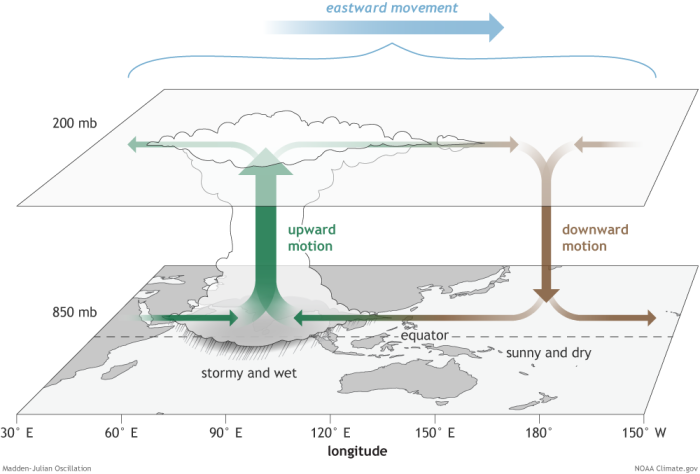
It is known that climate change will impact the large-scale (i.e., >1000 km) atmospheric patterns which impact our weather, however what these changes will be and when they will occur is a big question in climate science. These large-scale patterns, known as climate modes, include the El Niño–Southern Oscillation, the Indian Ocean Dipole and the Madden-Julian Oscillation.
Recent work by Dr Hien Bui, a research fellow at the ARC Centre of Excellence for Climate Extremes has improved our understanding of how climate change may influence the Madden-Julian Oscillation. In particular, when the impacts of climate change may be seen and what these changes may be.
Why is the Madden-Julian Oscillation important?
The Madden-Julian Oscillation is an important climate phenomenon which causes tropical (30oS-30oN) rainfall to alternate between enhanced and suppressed periods within a season. This climate mode can have a big impact on how wet or dry the weather is in areas like northern Australia.
The Madden-Julian Oscillation takes 30-90 days to travel around the globe and so it impacts tropical rainfall on weekly to monthly timescales.
Although the Madden-Julian Oscillation occurs in the tropics, its reach is much broader, influencing everything from the Indian monsoon to tropical cyclones in the western North Pacific, and heatwaves, droughts and flooding in many regions.
Global warming can change the moisture content in the atmosphere as well as the circulation, impacting many large-scale climate phenomena including the Madden-Julian Oscillation.
Improving how climate models simulate the Madden-Julian Oscillation
“There are typically two challenges when examining how future warming will affect the Madden-Julian Oscillation” explains Dr Bui.
“Climate models are required to look at future climate, but the first challenge is whether the model can simulate a realistic Madden-Julian Oscillation in the present.”
This is important because future projections are unlikely to be meaningful if the model cannot simulate the Madden-Julian Oscillation well in the current climate.
“The second challenge arises from near-term natural variability in the climate system – such as El Niño–Southern Oscillation, which can make it hard to measure whether changes we see are due to greenhouse gasses or normal fluctuations in the climate.”
To address these research challenges, Dr Bui used a climate model which is known to simulate the Madden-Julian Oscillation well, the Community Earth System Model version 2 Large Ensemble (CESM2-LE). To overcome the problem of separating natural variability from changes due to climate change, the researchers analysed 100 ensembles from the model.
“An ensemble is a set of model simulations where the modeller uses different initial conditions that produce a different depiction of the projected climate on short and long timescales. This helps to evaluate how sensitive the model is to natural fluctuations in the climate” explains Dr Bui.

New studies analyse the Madden-Julian Oscillation in a warming climate
Dr Bui has carried out two studies. The first one looked at how the Madden-Julian Oscillation may change in a future warmer climate.
“We were looking for when in the future this climate change signal can be detected. We found that changes in Madden-Julian Oscillation rainfall and wind strength relative to the historical record become detectable late in the 21st century if the climate warms in line with a medium to high emissions scenario.”
The authors also found that changes in Madden-Julian Oscillation rainfall strength were detectable more than a decade earlier than Madden-Julian Oscillation wind amplitude changes.
“This suggests that some impacts of climate change on Madden-Julian Oscillation rainfall are expected to happen earlier than those related to Madden-Julian Oscillation wind changes” explains Dr Bui.
The researchers also looked at what the impacts might be across seasons, as these are the impacts that people will experience at the local scale.
In the second study, Dr Bui and a colleague examined how the Madden-Julian Oscillation changes throughout the year, given that previous analyses only focused on the annual and/or seasonal-average of the Madden-Julian Oscillation. The authors found a delay of 1-2 weeks in the seasonal phase of the Madden-Julian Oscillation.
This means that the impacts of the Madden-Julian Oscillation on rainfall would occur later in the season than usual, which has direct impacts on agriculture.
“The results show the importance of better monitoring and prediction of the Madden-Julian Oscillation to understand its local impacts in a warming climate” says Dr Bui.
“It’s also important to continue to investigate how the Madden-Julian Oscillation may influence extreme events in the future.”
What are the future impacts of the Madden-Julian Oscillation in a warming climate?
As the tropical climate warms, the intensity of rainfall and winds associated with the Madden-Julian Oscillation as well as their patterns may change, leading to intense debate and scrutiny of how extratropical weather will be affected.
Dr Bui and colleagues are continuing to look at these issues, with a focus on how the Madden-Julian Oscillation impacts extreme climate events such as flooding, drought and bushfires over the Australian continent.
